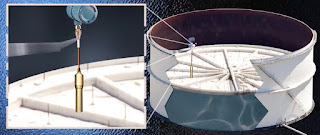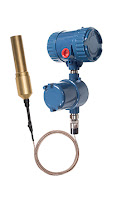 |
| Animation of vortices* |
Vortex flowmeters operate based on a scientific principle called the von Karman effect, which generally states that a fluid flow will alternately shed vortices when passing by a solid body. "Vortices" is the plural form of vortex, which is best described as a whirling mass, notably one in which suction forces operate, such as a whirlpool. Detecting the presence of the vortices and determining the frequency of their occurrence is used to provide an indication of fluid velocity. The velocity value can be combined with temperature, pressure, or density information to develop a mass flow calculation. Vortex flowmeters exhibit high reliability, with no moving parts, serving as a useful tool in the measurement of liquid, gas, and steam flow.
 |
| Photograph of vortices ** |
Rangeability, defined as a ratio of maximum to minimum flow, is an important consideration for any measurement instrument, indicating its ability to measure over a range of conditions. Vortex flowmeter instruments generally exhibit wide rangeability, one of the positive aspects of the technology and vortex based instruments.
The advantages of the vortex flowmeter, in addition to the aforementioned rangeability and steam-specific implementation, include available accuracy of 1%, a linear output, and a lack of moving parts. It is necessary for the pipe containing the measured fluid to be completely filled in order to obtain useful measurements.
 |
| Vortex flowmeter (Azbil) |
When properly applied, the vortex flowmeter is a reliable and low maintenance tool for measuring fluid flow. Frequently, vortex flow velocity measurement will be incorporated with the measurement of temperature and pressure in an instrument referred to as a multivariable flowmeter, used to develop a complete measurement set for calculating mass flow.
Whatever your flow measurement challenges, share them with a flow instrument specialist, combining your process knowledge with their product and technology expertise to develop effective solutions.
* Animation of vortex creation credit Cesareo de La Rosa Siqueira via Wikipedia.
** Photograph of vortices credit Jürgen Wagner via Wikipedia.




